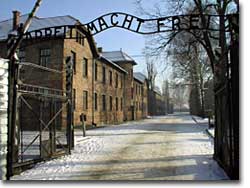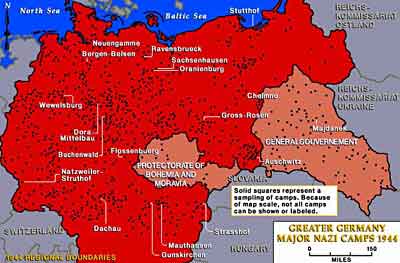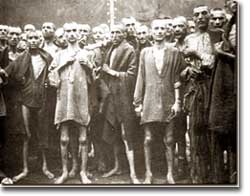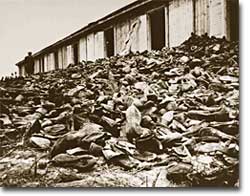| HOME |
The genocidal campaign the Nazis waged against Europe's Jewish population was unprecedented in human history largely because of the systematic manner in which the capture and killing of Jews occurred. In the summer of 1941, Hitler ordered his forces to begin the "final solution" to the Jewish presence in Europe. Hitler determined that mass execution of Jewish civilians, who lived in Europe in great numbers for over 1,000 years, was the ultimate means of purifying the German race. Members of the SS Nazi death squads began to roam Soviet Russia and Eastern Europe massacring Jews and Russian prisoners of war. Nazis in France, Holland, Norway, Denmark, and other occupied countries searched for Jews, sending them to the Nazi death camps that had been established along Germany's eastern border.
German companies like I.G. Farben bid on contracts to supply those camps with gas, ovens, and other instruments of death, offering written guarantees of their efficiency and durability. The impetus for exterminating Jews even outweighed military considerations. Railways continued to transport Jews to the camps towards the end of the war, despite the German army's urgent demand for rail cars and slave labor. At the camps, German commanders tinkered with the efficiency of their killing systems. Nazi doctors and scientists conducted experiments on Jews and other prisoners. Gold and other assets were taken. Camp prisoners were worked to death. The head of the slave-labor system had ordered: "All the inmates must be fed, sheltered and treated in such a way as to exploit them to the fullest possible extent, at the lowest conceivable degree of expenditure."
Throughout the war, Jews by the thousands had been deported from Germany and sent to concentration camps. Some German citizens participated in the expulsions, informing on Jews' whereabouts to the Gestapo, the Nazi state police. Many did so out of fear as much as a shared anti-Semitism. But as evidence of mass killings became known, such citizen complicity diminished. The Allies became aware of the death camps in late 1942, though the scale of the killings was perhaps not known until later in the war. The Allies' decision not to bomb the railway links leading to the camps was a difficult one. There was no military solution available at the time, as German airspace was difficult to penetrate, and the priority of the commanders was organizing effective counterattacks in Western Europe and bombing German industrial targets. But Allied leaders did little else but warn German leaders that they would be held accountable, failing to facilitate to any great extent the emigration of Jews to safe countries. When Allied troops liberated the camps in the spring of 1945, they found emaciated survivors, thousands of whom eventually died from disease or malnutrition. After the war ended, Allied soldiers escorted German civilians around camps like Buchenwald to help 'de-Nazify' Germany. Many of them wept as they saw the dead and the living dead. The Nuremberg trials that began in September 1945 exposed the barbarity of the Holocaust. Nazi after Nazi testified that they were just following orders from superiors.
|
||||
| MAIN | |||||
| INVESTIGATION CENTRAL | |||||
|
|||||



